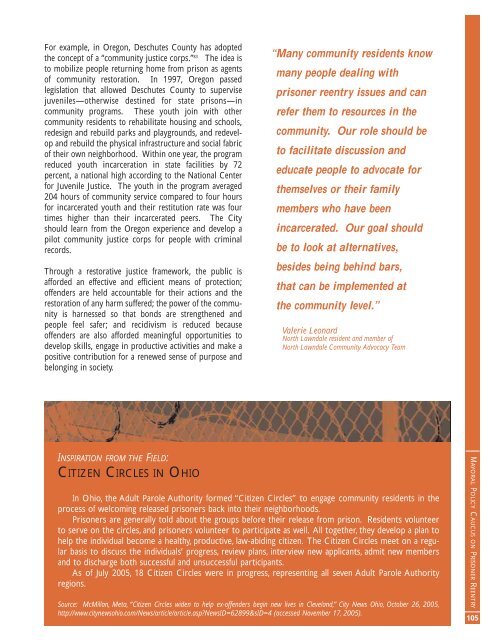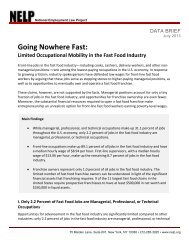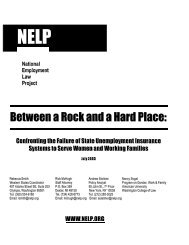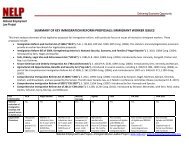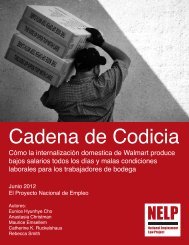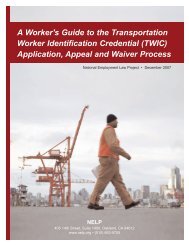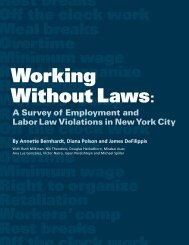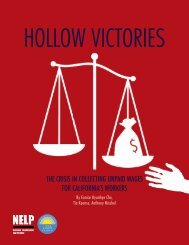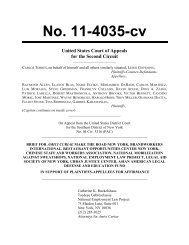Rebuilding Lives. Strengthening Communities.
Rebuilding Lives. Strengthening Communities.
Rebuilding Lives. Strengthening Communities.
Create successful ePaper yourself
Turn your PDF publications into a flip-book with our unique Google optimized e-Paper software.
For example, in Oregon, Deschutes County has adopted<br />
the concept of a “community justice corps.” 83 The idea is<br />
to mobilize people returning home from prison as agents<br />
of community restoration. In 1997, Oregon passed<br />
legislation that allowed Deschutes County to supervise<br />
juveniles—otherwise destined for state prisons—in<br />
community programs. These youth join with other<br />
community residents to rehabilitate housing and schools,<br />
redesign and rebuild parks and playgrounds, and redevelop<br />
and rebuild the physical infrastructure and social fabric<br />
of their own neighborhood. Within one year, the program<br />
reduced youth incarceration in state facilities by 72<br />
percent, a national high according to the National Center<br />
for Juvenile Justice. The youth in the program averaged<br />
204 hours of community service compared to four hours<br />
for incarcerated youth and their restitution rate was four<br />
times higher than their incarcerated peers. The City<br />
should learn from the Oregon experience and develop a<br />
pilot community justice corps for people with criminal<br />
records.<br />
Through a restorative justice framework, the public is<br />
afforded an effective and efficient means of protection;<br />
offenders are held accountable for their actions and the<br />
restoration of any harm suffered; the power of the community<br />
is harnessed so that bonds are strengthened and<br />
people feel safer; and recidivism is reduced because<br />
offenders are also afforded meaningful opportunities to<br />
develop skills, engage in productive activities and make a<br />
positive contribution for a renewed sense of purpose and<br />
belonging in society.<br />
“Many community residents know<br />
many people dealing with<br />
prisoner reentry issues and can<br />
refer them to resources in the<br />
community. Our role should be<br />
to facilitate discussion and<br />
educate people to advocate for<br />
themselves or their family<br />
members who have been<br />
incarcerated. Our goal should<br />
be to look at alternatives,<br />
besides being behind bars,<br />
that can be implemented at<br />
the community level.”<br />
Valerie Leonard<br />
North Lawndale resident and member of<br />
North Lawndale Community Advocacy Team<br />
INSPIRATION FROM THE FIELD:<br />
CITIZEN CIRCLES IN OHIO<br />
In Ohio, the Adult Parole Authority formed “Citizen Circles” to engage community residents in the<br />
process of welcoming released prisoners back into their neighborhoods.<br />
Prisoners are generally told about the groups before their release from prison. Residents volunteer<br />
to serve on the circles, and prisoners volunteer to participate as well. All together, they develop a plan to<br />
help the individual become a healthy, productive, law-abiding citizen. The Citizen Circles meet on a regular<br />
basis to discuss the individuals’ progress, review plans, interview new applicants, admit new members<br />
and to discharge both successful and unsuccessful participants.<br />
As of July 2005, 18 Citizen Circles were in progress, representing all seven Adult Parole Authority<br />
regions.<br />
Source: McMillan, Meta, “Citizen Circles widen to help ex-offenders begin new lives in Cleveland,” City News Ohio, October 26, 2005,<br />
http://www.citynewsohio.com/News/article/article.aspNewsID=62899&sID=4 (accessed November 17, 2005).<br />
MAYORAL POLICY CAUCUS ON PRISONER REENTRY<br />
105


